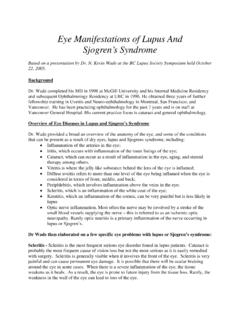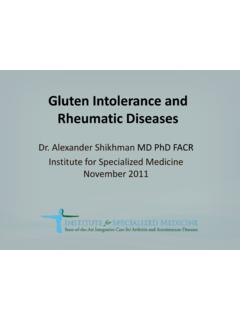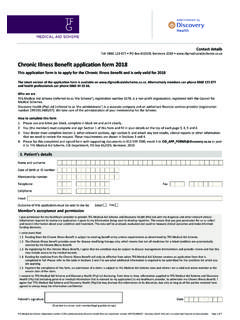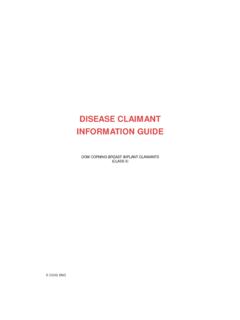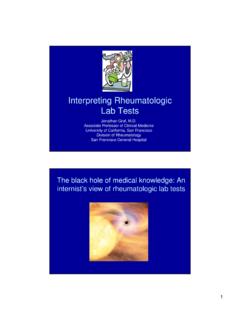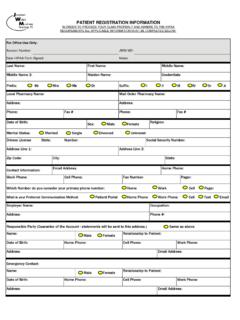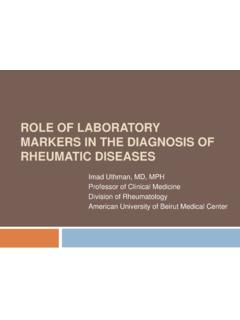Transcription of Journal of Autoimmunity - Humberside …
1 Diagnosis and classification of the antiphospholipid syndromeJose A. G mez-Puertaa,b, Ricard Cerveraa,*aDepartment of Autoimmune Diseases, Hospital Cl nic, Barcelona, Catalonia, SpainbDivision of Rheumatology, Immunology and Allergy, Section of Clinical Sciences, Brigham and Women s Hospital, Boston, MA, USAarticle infoArticle history:Received 7 October 2013 Accepted 13 November 2013 Keywords:Antiphospholipid syndromeAnticardiolipin antibodiesLupus anticoagulantCatastrophic antiphospholipid syndromeabstractThe antiphospholipid syndrome (APS) is defined by the occurrence of venous and arterial thromboses,often multiple, and recurrent fetal losses, frequently accompanied by a moderate thrombocytopenia, inthe presence of antiphospholipid antibodies (aPL).
2 Some estimates indicate that the incidence of the APSis around 5 new cases per 100,000 persons per year and the prevalence around 40e50 cases per 100,000persons. The aPL are positive in approximately 13% of patients with stroke, 11% with myocardialinfarction, of patients with deep vein thrombosis and 6% of patients with pregnancy morbidity. Theoriginal classification criteria for the APS were formulated at a workshop in Sapporo, Japan, in 1998,during the 8th International Congress on aPL. The Sapporo criteria, as they are often called, were revisedat another workshop in Sydney, Australia, in 2004, during the 11th International Congress on aPL. At leastone clinical (vascular thrombosis or pregnancy morbidity) and one laboratory (anticardiolipin antibodies,lupus anticoagulant or anti-b2-glycoprotein I antibodies) criterion had to be met for the classification ofAPS.
3 2014 Elsevier Ltd. All rights IntroductionThe antiphospholipid syndrome (APS) is defined by the occur-rence of venous and arterial thromboses, often multiple, andrecurrent fetal losses, frequently accompanied by a moderatethrombocytopenia, in the presence of antiphospholipid antibodies(aPL), namely lupus anticoagulant (LA), anticardiolipin antibodies(aCL), or anti-b2glycoprotein-I (b2 GPI) antibodies[1]. The APS canbe found in patients having neither clinical nor laboratory evidenceof another definable condition (primary APS) or it may be associ-ated with other diseases, mainly systemic lupus erythematosus(SLE), but occasionally with other autoimmune conditions[1], in-fections[2], drugs[1], and malignancies[3](Table 1).Primary APS patients rarely progresses to SLE.
4 Only 8% of 128patients, who were followed up for about 9 years, developed lupus,and a positive Coombs test was a clinically significant predictor ofprogression[4].The aPL can appear in different scenarios, such as asymptomatic carrier patients for aPL, classical APS with recurrent venousand/or arterial thrombosis, APS affecting otherwise healthy womenwith recurrent pregnancy loss, patients with aPL positivity withnon-thrombotic aPL manifestations ( thrombocytopenia, he-molytic anemia orlivedo reticularis)[5]or, in a small subset of pa-tients, as a life-threatening form characterized by a rapiddevelopment of microthrombosis that led to rapid multiorganfailure, which is termed catastrophic APS[6].2. EpidemiologyPrevalence of the aPL in the general population ranges between1 and 5%.
5 However, only a minority of these individuals develop theAPS. Some estimates indicate that the incidence of the APS isaround 5 new cases per 100,000 persons per year and the preva-lence around 40e50 cases per 100,000 persons[7].Recently, the APS ACTION group (AntiPhospholipid SyndromeAlliance For Clinical Trials and InternatiOnal Networking) pub-lished a literature review focused in the prevalence of aPL in thegeneral population with pregnancy morbidity, stroke, myocardialinfarction (MI) and deep vein thrombosis (DVT). The authors esti-mated that aPL are positive in approximately 13% of patients withstoke, 11% with MI, of patients with DVT and 6% of patientswith pregnancy morbidity[8].The prevalence of the catastrophic APS is scarce (less than 1% ofall cases of APS)[6]but its potentially lethal outcome emphasizesits importance in clinical medicine today[9,10].
6 In order to puttogether all the published case reports as well as the new diagnosedcases from all over the world, an international registry of patientswith catastrophic APS ( CAPS Registry ) was created in 2000 by the*Corresponding author. Servei de Malalties Autoimmunes, Hospital Cl nic, Vil-larroel 170, 08036 Barcelona, Catalonia, Spain. Tel.: 34 93 227 5774; fax: 34 93227 Cervera).Contents lists available atScienceDirectJournal of Autoimmunityjournal homepage: $esee front matter 2014 Elsevier Ltd. All rights of Autoimmunity 48-49 (2014) 20e25 European Forum on Antiphospholipid Antibodies. Currently, it docu-ments the entire clinical, laboratory and therapeutic data of morethan 400 patients whose data has been fully registered. This reg-istry can be freely consulted at the Internet ( ).
7 3. HistoryThe association of thrombosis, recurrent fetal losses andthrombocytopenia with the LA phenomenon was observed in earlypublications in the 60 s, but it was not until 30 years ago thatGraham Hughes linked major cerebral disease ( recurrentstrokes) with abortions and the LA in an editorial published in theBritish Medical Journal [11]. The original concept of the APS,however, has been expanded over the years and now includesdiverse complications as heart valve lesions, adrenal insufficiencyand even avascular necrosis of bone, among many others[5,12].A major advance came in the early 1990s with the simultaneousrecognition by different groups that aPL required a plasma protein cofactor to bind cardiolipin on ELISA plates[13,14].b2GP1 wasidentified as this cofactor.
8 Since then, a number of cofactors including prothrombin, have been PathogenesisDespite the strong association between aPL and thrombosis, thepathogenic role of aPL in the development of thrombosis has notbeen fully elucidated. Available data indicate that many of the au-toantibodies associated with APS are directed against a number ofplasma proteins and proteins expressed on, or bound to, the surfaceof vascular endothelial cells or platelets. The involvement of aPL inclinically important normal procoagulant and anticoagulant re-actions and on certain cells altering the expression and secretion ofvarious molecules may offer a basis for definitive investigations ofpossible mechanisms by which aPL may develop thrombotic eventsin patients with APS (Table 2)[15,16].
9 5. Clinical manifestationsThe clinical picture of the APS is characterized by venous andarterial thromboses, fetal losses and thrombocytopenia. Singlevessel involvement or multiple vascular occlusions may give rise toa wide variety of presentations. The baseline characteristics of acohort of 1000 patients with APS ( Euro-Phospholipid Project )arecollected inTable 3 [17]. Any combination of vascular occlusiveevents may occur in the same individual and the time intervalbetween them also varies considerably from weeks to months oreven years. After a 5-year follow-up of the 1000 patients with APSfrom the Euro-Phospholipid Project , a bunch of new APS featuresappeared over time[18]. Those manifestations included thrombo-cytopenia ( ),livedo reticularis( ), stroke ( ), transientischemic attacks ( ), DVT ( ), pulmonary embolism ( ),epilepsy ( ), valve vegetations ( ) and MI (1%), among Laboratory abnormalitiesA wide variety of laboratory abnormalities can be found in pa-tients with APS, depending on the organ involvement.
10 The mostcommon immunological features are depicted inTable 4. Detectionof the LA must be performed according to the guidelines of theInternational Society on Thrombosis and Hemostasis (ScientificSubcommittee on Lupus Anticoagulants/Phospholipid-DependentAnt ibodies)[19].7. Classification criteriaIn 1999, a preliminary classification criterion was establishedafter an expert workshop held in Sapporo, Japan[20]. Morerecently, another workshop was held in Sydney, Australia, in whichthe experts proposed some modifications to the previous criteria,such as the inclusion of anti-b2 GPI antibodies. Although no newclinical criteria were added, some particular features wereremarked on, such as associated APS features, including cardiacvalve involvement,livedo reticularis, thrombocytopenia, APS ne-phropathy, and non-thrombotic central nervous system manifes-tations ( cognitive dysfunction)[21](Table 5).
